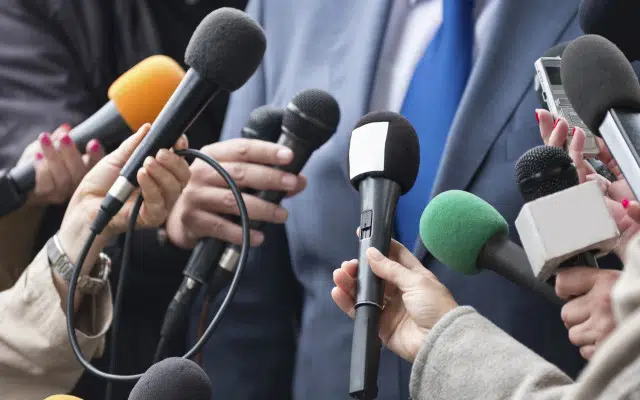Media interviews can be nerve-wracking. But did you know that the fear of public speaking, Glossophobia, is America’s No.1 phobia? Most surprisingly, it’s ranked higher than a fear of death or spiders, which are ranked No. 2 and No. 3, respectively.
I’ve experienced it first-hand during my career working at tech PR and marketing firms. Even the savviest CEO’s confidence quickly diminishes and anxiety takes over when it comes to media interviews. Why? They probably think of the worst interviews they’ve seen. Yes, one of those interviews…a tough and ruthless investigative reporter grills a high-powered CEO with cutting questions about a recent scandal. And we all know that it only takes one interview for the CEO’s reputation and credibility to instantly melt away in the public’s eyes, which could lead to a serious crisis communications situation.
But fear not, the majority of the media interviews are not confrontational. As a technology PR professional, I work with business and tech reporters on a daily basis, and their missions are usually quite clear – to write fresh, compelling stories for their readers. It’s true that the first interview is usually a bit challenging, but preparation and practice can make a huge difference in the outcome.
One of the best ways to prepare for an interview is to work with a PR professional who can guide you on “media interview Dos and Don’ts” and lead you through several rounds of mock interviews. I want to share the following eight tips for successful media interviews based on my experience conducting numerous media training sessions for C-level executives:
1. Research everything.
As before any first meeting with a new business prospect, be sure to research the reporter’s background, as well as the publication’s mission and readership. Remember that each media interview is the beginning of a long-term relationship with the reporter. Reading the reporter’s recent articles is helpful, but don’t forget to check his or her Twitter account and LinkedIn profile for additional personal details. You can often find common interests and shared background that would help you build strong rapport with the reporter.
Good journalists will be doing the same research on you! According a survey conducted by the Public Relations Global Network (PRGN), 80 percent of North American journalists browse an executive’s LinkedIn profile before an interview. Twitter and Facebook came in second and third.
2. Get your facts straight.
This seems like a simple task, but can you quickly answer basic facts about your company, particularly number-related ones like the company’s revenues, funding history, workforce numbers at each office location, customer numbers, etc.? Make sure to confirm the facts with your executive team (and your PR person, of course!), and create a standard fact sheet beforehand that you can have out during the interview.
3. Figure out your key messages.
Develop key messages with supporting evidence and prepare to use them throughout the interview. The key messages should be compelling and concisely describe what makes your company unique. Remember, the success of an interview depends on whether your key messages appear in the article. Practice until you feel completely comfortable delivering your key messages in public.
4. Don’t be afraid to ask questions.
This might surprise you, but it’s entirely OK to ask the reporters about the focus of the interview and if they can send a list of their expected questions ahead of time. Generally, reporters are happy to do this because they know it will help you provide better answers, and that means they get a better story.
5. Be a good expert resource.
Be helpful and always try to be a good expert resource for journalists. Your objective is to establish and maintain good rapport throughout the interview. Providing insightful comments about their recent articles or the latest industry trends are a great start, and the journalists often appreciate them and think of you as an industry expert/resource the next time they write a trend story. Remember, you want to become their go-to source on your industry because that will drive more exposure for your company.
6. Don’t speak too quickly.
Phone interviews can be difficult because you cannot see what the reporters are doing during the interview. Most likely the reporters are taking notes, so it’s wise to talk more slowly than usual. Some reporters prefer to record the entire phone interview, and they usually let you know about it at the beginning of the interview.
7. Nothing is “off the record.”
Remember the cardinal rule of working with journalists: nothing is “off the record.” You might be tempted to let your guard down and share speculation about your competitors or industry insider information to improve your rapport, but this can be a serious mistake. If you don’t want it made public, do not mention it. Period.
8. Follow up promptly.
Not all interviews make it into the final published article. Following up with the reporter soon after your interview, however, can dramatically increase the odds that the reporter includes you in their final draft. Following up puts you in the position to quickly answer any additional questions, provide a headshot or any relevant graphic files. Ask about their deadlines and send follow-up materials promptly.
Once the article is published, your work is not complete. The value of media coverage depends heavily on how you capitalize on it after the publication. Promote them via your company’s website and social media channels, and highlight them in sales and investor presentations. Money cannot buy these valuable third-party endorsements. Take advantage of the power of earned media, which is proven to help bring new business leads, accelerate sales process, elevate your brand awareness and build your company’s credibility in the marketplace.
Ready for your next media interview? Give us a shout if you need help!

